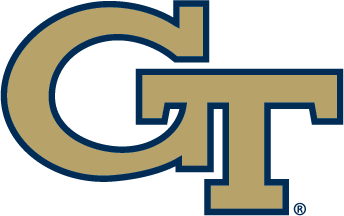By Matt Winkeljohn | The Good Word
Georgia Tech’s eldest players did not play a whole lot of doubles while growing up in juniors tennis, yet as seniors Paige Hourigan and Johnnise Renaud know that part of the college game is every bit as important as singles, and maybe more-so.
Let’s go to numbers to illustrate for the No. 2-ranked Yellow Jackets, for whom head coach Rodney Harmon has changed pairings several times this winter/spring.
Tech has won the doubles point to open 16 dual matches this spring, and in those matches, they’re 15-1. In four matches where the Jackets dropped doubles, they’re 1-3.
Now, to testimonials, where there may be no better speakers than Paige and Johnnise. Hourigan is 98-26 (79 percent) in doubles in her Tech career. Renaud is 96-27 (78 percent).
They currently rank No. 1 and No. 2, respectively, in Tech history in doubles winning percentage.
And they’ll tell you that because the doubles point is played out first, it’s worth more than 1/7th of the team points that go into college duals. It’s quite the jump start heading into singles.
“I feel like in juniors you’re not really too interested in playing doubles just because you’re either traveling by yourself or you couldn’t find a solid partner,” said Renaud, whose 96 career doubles wins rank fifth in program history. “If you have the doubles point, and one of us wins quickly then you’re up 2-0 and you don’t feel as much stress.
“We practice doubles every single day . . . if you don’t have the intensity and energy to win – because it’s only six points — then [the entire match] can go like that.”
Hourigan played doubles sparingly while growing up in New Zealand, much like Renaud as she grew up in south Florida. It’s big now.
“You work on doubles a lot here. In juniors, it was just kind of an extra thing,” said Hourigan, whose 98 doubles wins tie Alison Silverio (2005-’08) for third in program history behind Kristi Miller’s 110 and Whitney McCray’s 101. “I feel like in juniors if you can volley, you can do well in doubles.
“But here, it’s more hype around doubles. It’s such a big thing because obviously the [first] point helps you.”
The Jackets have won 60 of 85 singles matches this school year, including fall tournaments that were not dual matches, for a winning percentage of .706.
That’s saying quite a bit, especially since Harmon has shuffled combinations frequently.
With the exception of the nation’s top-ranked duo of Hourigan and sophomore Kenya Jones at the No. 1 spot, where they’ve played for all 10 ACC matches but not all school year, the Jackets have played some musical chairs in doubles in conference action.
Freshman Ida Jarlskog and Flores have played just seven times, going 1-2 in the fall. They’re 4-0 and ranked No. 61 since being paired together for the last three weekends.
It helps that they combined for wins at No. 1 North Carolina on March 24 to jumpstart Tech’s upset of the Tar Heels, and against No. 4 Duke when they topped No. 5 Kelly Chen and Samantha Harris 7-6 (7-5) on April 5. Tech won the doubles point each time.
A coach doesn’t just slap players together. Their styles matter, and so does their chemistry.
Harmon said that some players are more comfortable on the left side, which he calls “ad,” and some are more comfortable on the right side, which he calls, “deuce.”
Tech’s head coach and assistant Christy Lynch — whose .667 winning percentage built from 2006-’09 is tied for seventh-best in Tech history — sometimes play hunches. They’ve also juggled lineups because of player illnesses.
“It’s always 50-50,” Harmon said. “There are some obvious limitations if you can only play one side of the court. Where it does have some flexibility of court is when a person can play both sides.
“It’s a feel thing. It’s just a feel for what you think might work at the time . . . You’re just naturally better at one or the other.”
Flores prefers the left side, and she’s something of an exception in that she sought to play a lot of doubles while coming up through junior tennis.
“I think I’ve always been better on ad,” she said. “I’m not sure why, but I’m definitely more comfortable there. It helps that we’re such good friends that when we play it’s almost natural . . .
“I usually played doubles almost every single time. One of my strengths is volley, and I like being at the net, so I’m comfortable being up there and I think it’s just good practice. You get to hit more balls and learn new things with different partners.”
Chemistry matters.
“During the point there’s no communication unless someone lobs and you say, ‘Mine’ or ‘I’m coming in,” Hourigan said. “You just kind of lay out what we want to do, and if it happens it happens, and if not you just kind of improvise because you know your teammate well enough to know that’s what they’re going to do.”
That’s another part of the chemistry equation. Generally, one player is more comfortable approaching the net than another. Between points, teams may make other adjustments.
“We give them certain leeway, but there are teams with more formation changes than others,” Harmon said. “You can do all the planning and changes and formation switches you want, but it still comes down to making first serves, returning, being effective and finishing at the net.
“It’s like football; you can have all the fancy plays, but if you’re not winning on the offensive and defensive lines, it’s window dressing.”
The Jackets have doubles-paned windows.
Two of their best wins of the season, at North Carolina and against Duke, came against squads that currently each have five of their six players in the national singles rankings.
Tech has two in No. 12 Hourigan and No. 74 Jones.
Yet the Jackets beat them both, first by winning the doubles point.
Need more evidence that the doubles point is critical?
How about this: look at the best stretch in Tech women’s tennis history.
From 2005-’08 — when the Jackets finished first in the ACC regular season for the only four times in program history, and also won an ACC tournament title, a national title in 2007 and a national indoor title — the teams included excellent top doubles players.
Six of the top 15 career doubles winning percentages in program history are held by members of those teams, and seven of the top 16 marks in career wins were on those squads.
Ironically, when Tech won the NCAA title in 2007, the Jackets lost the doubles point, and it came down to singles. So, there’s that.
Tech has done that this season, too, losing the doubles point March 2 against No. 16 Virginia. There, the combinations of Jarlskog/Renaud and Hourigan/Jones fell.
The Jackets rallied, winning 4-3 when Hourigan, then ranked No. 25, beat No. 67 Rosie Johanson 6-7 (3-7), 6-1, 6-3.
It’s a whole lot easier winning the doubles point first.
“You really have to come out ready to play,” Harmon said. “It can be very difficult to catch up.”









